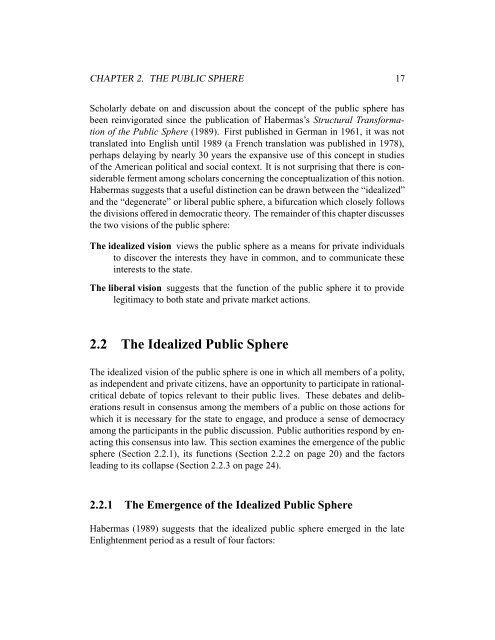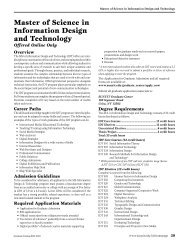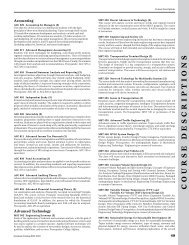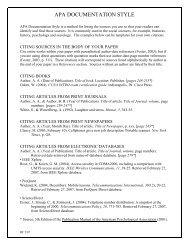Expanding the Public Sphere through Computer ... - ResearchGate
Expanding the Public Sphere through Computer ... - ResearchGate
Expanding the Public Sphere through Computer ... - ResearchGate
You also want an ePaper? Increase the reach of your titles
YUMPU automatically turns print PDFs into web optimized ePapers that Google loves.
CHAPTER 2. THE PUBLIC SPHERE 17<br />
Scholarly debate on and discussion about <strong>the</strong> concept of <strong>the</strong> public sphere has<br />
been reinvigorated since <strong>the</strong> publication of Habermas’s Structural Transformation<br />
of <strong>the</strong> <strong>Public</strong> <strong>Sphere</strong> (1989). First published in German in 1961, it was not<br />
translated into English until 1989 (a French translation was published in 1978),<br />
perhaps delaying by nearly 30 years <strong>the</strong> expansive use of this concept in studies<br />
of <strong>the</strong> American political and social context. It is not surprising that <strong>the</strong>re is considerable<br />
ferment among scholars concerning <strong>the</strong> conceptualization of this notion.<br />
Habermas suggests that a useful distinction can be drawn between <strong>the</strong> “idealized”<br />
and <strong>the</strong> “degenerate” or liberal public sphere, a bifurcation which closely follows<br />
<strong>the</strong> divisions offered in democratic <strong>the</strong>ory. The remainder of this chapter discusses<br />
<strong>the</strong> two visions of <strong>the</strong> public sphere:<br />
The idealized vision views <strong>the</strong> public sphere as a means for private individuals<br />
to discover <strong>the</strong> interests <strong>the</strong>y have in common, and to communicate <strong>the</strong>se<br />
interests to <strong>the</strong> state.<br />
The liberal vision suggests that <strong>the</strong> function of <strong>the</strong> public sphere it to provide<br />
legitimacy to both state and private market actions.<br />
2.2 The Idealized <strong>Public</strong> <strong>Sphere</strong><br />
The idealized vision of <strong>the</strong> public sphere is one in which all members of a polity,<br />
as independent and private citizens, have an opportunity to participate in rationalcritical<br />
debate of topics relevant to <strong>the</strong>ir public lives. These debates and deliberations<br />
result in consensus among <strong>the</strong> members of a public on those actions for<br />
which it is necessary for <strong>the</strong> state to engage, and produce a sense of democracy<br />
among <strong>the</strong> participants in <strong>the</strong> public discussion. <strong>Public</strong> authorities respond by enacting<br />
this consensus into law. This section examines <strong>the</strong> emergence of <strong>the</strong> public<br />
sphere (Section 2.2.1), its functions (Section 2.2.2 on page 20) and <strong>the</strong> factors<br />
leading to its collapse (Section 2.2.3 on page 24).<br />
2.2.1 The Emergence of <strong>the</strong> Idealized <strong>Public</strong> <strong>Sphere</strong><br />
Habermas (1989) suggests that <strong>the</strong> idealized public sphere emerged in <strong>the</strong> late<br />
Enlightenment period as a result of four factors:
















